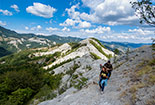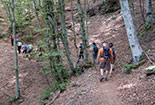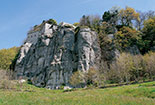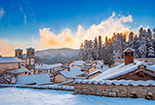BAGNO DI ROMAGNA AND RIDRACOLI
a spa place and a dam in the mountains of the National Park in Tuscan Romagna
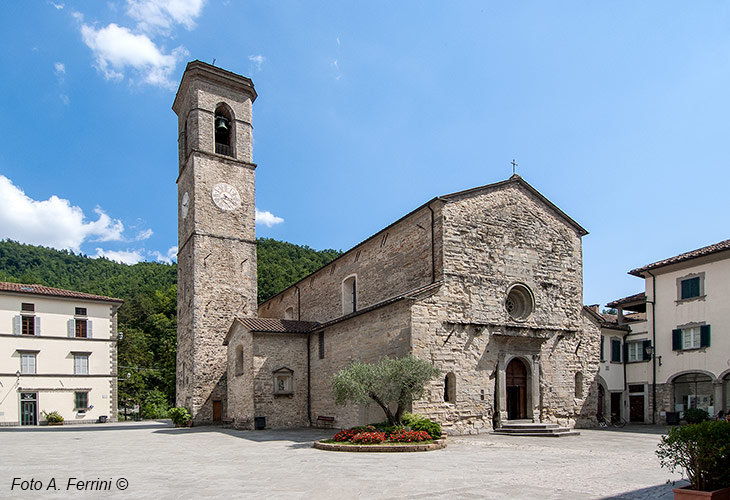
Texts and photos by Alessandro Ferrini ©
20 accurately described images about Bagno of Romagna and the tuscan Romagna. Click to enlarge
Bagno di Romagna and the Tuscan Romagna
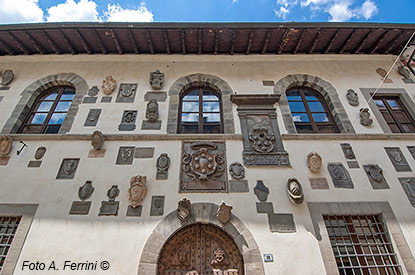 Since ancient times Bagno di Romagna has had close ties with the Casentino. The current connection between these two places is represented by the Regional Road 71 of the Mandrioli Pass. This road was opened in 1882 and then expanded in the 1930s when the first motorized vehicles needed suitable roads. The Romagna town can be reached from the two major centers of the first land of the Arno, Bibbiena and Poppi, in about 35 kilometers. The previous connection between the middle and lower Casentino with Bagno di Romagna was represented by the road that crossed the Apennines at the Passo di Serra. This route was certainly widely practiced since the Middle Ages by pilgrims who went from north-eastern Italy and Germany to Rome, the City of the Popes. There is no precise historical evidence, but this road was probably also practiced in Roman times. Today this route is a fascinating and spectacular trekking route that in a few kilometers, but demanding, leads from the Romagna town to the Apennine ridge and then descends into the impervious Vallesanta, so called because it is in front of the Sacro Monte della Verna.
Since ancient times Bagno di Romagna has had close ties with the Casentino. The current connection between these two places is represented by the Regional Road 71 of the Mandrioli Pass. This road was opened in 1882 and then expanded in the 1930s when the first motorized vehicles needed suitable roads. The Romagna town can be reached from the two major centers of the first land of the Arno, Bibbiena and Poppi, in about 35 kilometers. The previous connection between the middle and lower Casentino with Bagno di Romagna was represented by the road that crossed the Apennines at the Passo di Serra. This route was certainly widely practiced since the Middle Ages by pilgrims who went from north-eastern Italy and Germany to Rome, the City of the Popes. There is no precise historical evidence, but this road was probably also practiced in Roman times. Today this route is a fascinating and spectacular trekking route that in a few kilometers, but demanding, leads from the Romagna town to the Apennine ridge and then descends into the impervious Vallesanta, so called because it is in front of the Sacro Monte della Verna.
Bagno di Romagna is crossed by the River Savio, still a "child" as its source is just above the Apennines. With its 126 kilometers it is the longest river in Romagna.
The town, being along an important road network that connected and connects Rome, Umbria and Tuscany with Romagna, especially Ravenna, the seat of an important port since ancient times, was already known from the Roman period. With the decline of the empire, the place followed a similar fate.
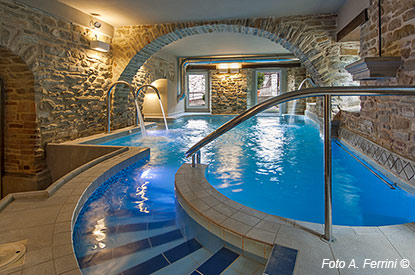 The ancient history of Bagno di Romagna was closely linked to its early Christian parish church which in the second half of the 9th century was transformed into a Benedictine monastery. In the twelfth century it passed to the Augustinian order, it is in this period that it is rebuilt in Romanesque forms still present on the outside. Given an important road network present, a market began to develop in the place that will become more and more well-known and organized with the domination of the territory of the powerful Guidi family. They worked on the fortification of the place and at the end of the thirteenth century favored the passage of the monastery to the Camaldolese order which will remain present until the early nineteenth century. In the early fifteenth century, the entire territory came under the jurisdiction of the Florentine Republic. The Grand Duchy of Tuscany administered the area until 1860. It should be remembered that the area was part of Tuscany until 1923 when Mussolini changed the regional borders with the main purpose of bringing the source of the Tiber, on nearby Monte Fumaiolo, back into the Province of Forlì where he was born. This territory that has changed region is now called Tuscan Romagna.
The ancient history of Bagno di Romagna was closely linked to its early Christian parish church which in the second half of the 9th century was transformed into a Benedictine monastery. In the twelfth century it passed to the Augustinian order, it is in this period that it is rebuilt in Romanesque forms still present on the outside. Given an important road network present, a market began to develop in the place that will become more and more well-known and organized with the domination of the territory of the powerful Guidi family. They worked on the fortification of the place and at the end of the thirteenth century favored the passage of the monastery to the Camaldolese order which will remain present until the early nineteenth century. In the early fifteenth century, the entire territory came under the jurisdiction of the Florentine Republic. The Grand Duchy of Tuscany administered the area until 1860. It should be remembered that the area was part of Tuscany until 1923 when Mussolini changed the regional borders with the main purpose of bringing the source of the Tiber, on nearby Monte Fumaiolo, back into the Province of Forlì where he was born. This territory that has changed region is now called Tuscan Romagna.
The current historical and architectural testimonies that recall the medieval and Renaissance age of Bagno di Romagna are essentially two: the Pieve di Santa Maria, (over the centuries it has been the subject of multiple restoration and reconstruction interventions, the most substantial in the sixteenth century) and the Palazzo del Capitano, administrative headquarters in Florence. On the facade of the building there are many noble coats of arms of the Florentine vicars who resided here over the course of several centuries. The Pieve di Santa Maria is very impressive for its architecture, but the place is also very interesting for the works of art that are preserved there. Since Bagno di Romagna has been subject to Florence since the beginning of the 15th century, the authors present in the church are mostly Florentines. There is a panel with the Virgin and Child from the first decade of the fifteenth century attributed to the Master of Sant’Ivo, a painter who trained in the Florentine workshop of Agnolo Gaddi 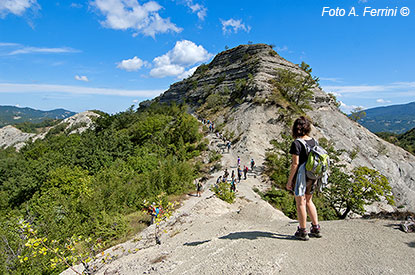 (son of the more famous Taddeo Gaddi, a pupil of Giotto). Given the period of construction of Bagno's work, this may have been one of the various expressions with which Florence affirmed its authority over the place. Still another panel by a Florentine, Neri di Bicci, shows the Madonna Assunta with Saints, 1467. From around 1490 is a beautiful Sant'Agnese, polychrome terracotta by Andrea della Robbia. Moving on to the 16th century we have a Nativity attributed to the Maestro del Tondo Borghese, an artist trained in the Ghirlandaio workshop, and a Virgin and Child from around 1560 by a Florentine, Michele Tosini, better known as Michele di Ridolfo del Ghirlandaio.
(son of the more famous Taddeo Gaddi, a pupil of Giotto). Given the period of construction of Bagno's work, this may have been one of the various expressions with which Florence affirmed its authority over the place. Still another panel by a Florentine, Neri di Bicci, shows the Madonna Assunta with Saints, 1467. From around 1490 is a beautiful Sant'Agnese, polychrome terracotta by Andrea della Robbia. Moving on to the 16th century we have a Nativity attributed to the Maestro del Tondo Borghese, an artist trained in the Ghirlandaio workshop, and a Virgin and Child from around 1560 by a Florentine, Michele Tosini, better known as Michele di Ridolfo del Ghirlandaio.
The history of the place is linked to the presence of thermal waters. Their beneficial properties were already highly appreciated by the Romans in the third century BC. they built the first baths which they called Balneum. These waters of alkaline bicarbonate sulphurous mineral type flow at a temperature of 45 degrees. Since the Middle Ages, when so many pilgrims passed through here from north-eastern Italy and Germany to Rome, they have represented the energy for economic development in Bagno di Romagna. Since the nineteenth century the place, thanks to its prestigious spas, has taken on a great reputation that goes far beyond national borders.
From Bagno di Romagna to return to Casentino it is possible to take two routes as an alternative to that of the Passo dei Mandrioli road, longer but of great beauty and particular significance.
From the town we can take the E45 towards Perugia Rome. Going out at Verghereto it is possible to visit the nearby source of the Tiber. Then continuing on the E45 we will exit at Pieve Santo Stefano. From this town, home to the interesting Museum of the Diary, we will go up towards La Verna using the Strada dello Spino, then from the Franciscan Sanctuary we will descend into the Casentino valley.
For the second route we must reach the nearby village of San Piero in Bagno, then turn left on the road that leads to Santa Sofia. Once in this town, take the road that will make us cross the Apennines on the Passo della Calla and then go down to Stia. A path that will take us through the magnificent forests of the National Park and get to know Campigna, a mountain holiday resort of the Grand Duke of Tuscany Pietro Leopoldo di Lorena. After a few kilometers from Santa Sofia, a fork on the left leads us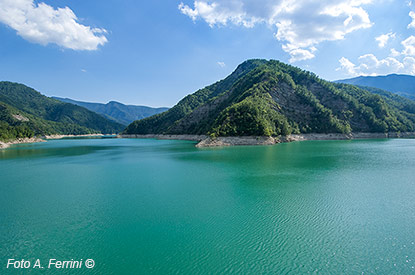 to the Ridracoli Dam. A large reservoir at 557 meters above sea level in the green mountains of the National Park built between 1974 and 1982. It is a large reserve of pure water as much as the streams that feed it, the Bidente and Rio Celluzze, have only crossed woods, no inhabited center. We could define it as the "cistern of the Romagna Riviera". It is possible to try your hand at naturalistic and scenic routes along the perimeter of the reservoir, or to travel it entirely on an electric boat. You can visit the nearby museum dedicated to the dam built in the building that for eight years housed those who worked on the construction of this colossal work, "an encounter between engineering and nature". From various points of the Apennine ridge we have a beautiful panoramic view of the Bidente Valley and the Ridracoli Dam. The most spectacular, evocative and free of any visual obstacles is offered by Monte Penna, reachable by a short path in the forest that starts from Aia di Guerrino, a clearing near Passo Fangacci on the road that connects the Hermitage of Camaldoli to Badia Prataglia.
to the Ridracoli Dam. A large reservoir at 557 meters above sea level in the green mountains of the National Park built between 1974 and 1982. It is a large reserve of pure water as much as the streams that feed it, the Bidente and Rio Celluzze, have only crossed woods, no inhabited center. We could define it as the "cistern of the Romagna Riviera". It is possible to try your hand at naturalistic and scenic routes along the perimeter of the reservoir, or to travel it entirely on an electric boat. You can visit the nearby museum dedicated to the dam built in the building that for eight years housed those who worked on the construction of this colossal work, "an encounter between engineering and nature". From various points of the Apennine ridge we have a beautiful panoramic view of the Bidente Valley and the Ridracoli Dam. The most spectacular, evocative and free of any visual obstacles is offered by Monte Penna, reachable by a short path in the forest that starts from Aia di Guerrino, a clearing near Passo Fangacci on the road that connects the Hermitage of Camaldoli to Badia Prataglia.



